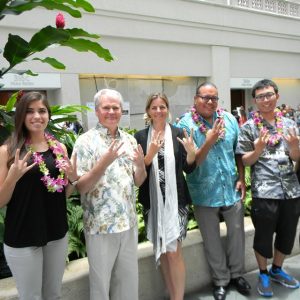June 26, 2017
 At a ceremony in Honolulu on June 18, 2017, an interdisciplinary team of Arizona State University graduate students working with Hawai’i Green Growth (HGG) received the top award in the Make the Ala Wai Awesome competition for their submission “Water is Life.”
At a ceremony in Honolulu on June 18, 2017, an interdisciplinary team of Arizona State University graduate students working with Hawai’i Green Growth (HGG) received the top award in the Make the Ala Wai Awesome competition for their submission “Water is Life.”
Submissions were judged by a prestigious panel that included representatives of the American Society of Landscape Architects Hawai’i chapter (Hawai’i ASLA). The Hawai’i ASLA members were so impressed with the ASU team’s submission that they granted it an additional HI-ASLA Award of Excellence.
The team’s success is the product of effective collaboration among ASU’s The Design School, School of Sustainability and Julie Ann Wrigley Global Institute of Sustainability, and the submission was part of a larger collaboration between ASU and HGG. The ASU design team assisted HGG and its partners to produce four products: a statewide sustainability assessment, a toolkit for communities in the Ala Wai Watershed, demonstration projects for the Ala Wai Canal, and a video to communicate the design ideas.
One of the collaboration’s primary aims was to create actionable projects and ideas to support the Aloha+ Challenge, Hawai‘i’s statewide 2030 sustainability goals. Students visited Hawai’i twice and actively listened to more than twenty groups across the state, which helped to shape their work.
The competition submission was a part of a year-long service-learning design studio that brought together Master of Landscape Architecture, Master of Urban Design and Doctoral School of Sustainability students to tackle wicked problems in Hawai’i. Team members were Kristin Antkoviak (MLA), Olga Bracamontes (MUD), Leah Gibbons (SOS), Nicholas Knoebel (MLA), Chunpeng Li (MUD), Catherine Ruggiero (MLA), Nicholas Weller (SOS) and Chandler Willie (MUD). Instructors for the studio were sustainability scientists Chingwen Cheng, Paul Coseo and Darren Petrucci.
The students have worked closely with Celeste Connors and Breanna Rose of HGG along with their numerous partners, whose diverse public, private, community and cultural perspectives helped make this project possible. It was supported with generous contributions from LightWorks, Herberger Institute for Design and the Arts and The Design School.

